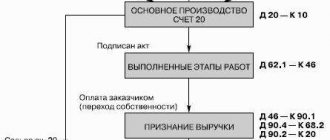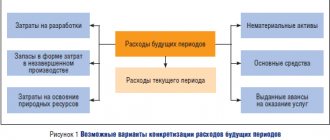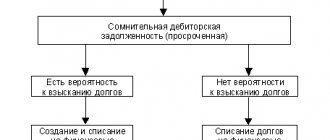general characteristics
Depending on the type of settlements, the corresponding subaccounts 76 of the accounting account for a separate type of operation are opened. Each of them is intended for grouping and further analysis of the economic processes of the enterprise in monetary terms. Among the accounts for certain types of obligations and settlements with debtors, you can find categories for accounting for unpaid wages for various reasons, insurance of property of the organization and employees, receivables from employees for the use of housing and communal services and other transactions not mentioned in accounts 60-75.
Closing
Unlike other accounts, when making payments to debtors and creditors, it is not always possible to summarize all the results at the end of the billing period and reduce its balance to zero.
Therefore, according to its structure, the account. 76 can be compared to count. 62 “Settlements with buyers and customers.” Closing is carried out as activities are carried out, namely, receipt of payments, accrual of leasing payments, compensation of prepayments with issued sales, etc.
Let's look at several examples of how closure will be carried out depending on the reflected business transaction.
https://youtu.be/TrzheReJ7tc
Main subaccounts of account 76
The accounting policy regulates the use of the following subaccounts of type 76.00:
- 76.01 - for accounting for settlements based on court documents;
- 76.02 - for accounting for amounts not received by employees for labor;
- 76.03 - for accounting for settlements with debtors for housing and communal services;
- 76.04 - for accounting for trade union dues and payments;
- 76.05 and 76.06 - for accounting for settlements with subsidiaries and dependent organizations, respectively;
- 76.07 - for calculations for payment of income;
- 76.08 - for settlements with individuals who do not work in the organization;
- 76.09 - for settlements on received and submitted claims;
- 76.10 - for settlements on insurance matters;
- 76.11 - to account for targeted fees for housing and communal services;
- 76.12 - for accounting for undetected amounts;
- 76.13 - for settlements with the state. organs;
- 76.80 - for other settlements with debtors and creditors.
Additionally, accounting account 76 is opened “VAT on advances and prepayments” and accounting account 76 “VAT on advances and prepayments issued”, which correspond to account 68. The use of VAT accounts is mandatory and important for all tax payer companies.
Purpose
Settlements with other debtors and creditors are carried out in one way or another in almost every organization. Any sub-accounts can be opened to the register at the discretion of the company, in addition to those specified in the Plan.
Basic business transactions requiring the use of an account. 76 are as follows:
- Additional insurance for employees. Compulsory medical is reflected on the account. 69.
- Claims from counterparties.
- Wages not received on time (deposited).
- Executive documents of employees.
- Other operations. These, for example, include settlements on loans issued by an organization to its founder, and on interest on the account balance accrued by the bank.
- Advances received and issued. In this case, on the account. 76 AB and 76 VA value added tax will be accumulated from the prepayment received or transferred
- Leasing payments, etc.
Account 76 is active-passive, so the balance can be either debit or credit.
Subaccount 76.01
In settlements based on enforcement documents, it is implied the withholding of funds from the amounts of remuneration for the labor of employees for the account of individuals and legal entities, based on court decisions and documents.
Let's consider possible types of correspondence of subaccount 76.01 with other accounts: Typical transactions using account 76.01
| Dt | CT | Characteristics of an accounting transaction |
| 70.01 | 76.01 | amount due due to court order withheld |
| 76.01 | 51 | the amount was paid according to the court decision from the current account |
| 76.01 | 50 | the amount of the court order was paid from the cash register |
| 50 or 51 | 76.01 | the previously transferred amount was returned to the cash register/account according to a court decision |
| 76.01 | 91.01 | writing off debts under court documents for enterprise income |
Subaccount 76.01 is debited with accounts 50 or 51 when the company makes the payment of the amounts required by executive documents. After the expiration of the limitation period for the documents, the debt amount is written off to the income of the enterprise and debited from 91.01 “Other income and expenses.”
The first entry in accounting for such a situation will be the correspondence of accounts 70 and 76.01, which reflects the process of withholding the amount payable. Subaccount 76.01 is credited with accounts 50, 51, 55 in the event that the organization returns amounts under executive documents.
Examples of accounting entries for account 76
The following transactions can be made with this account:
| Debit | Credit | Name |
| 76 | 20, 23, 29 | Write-off of part of the costs of main, auxiliary or servicing production to other debtors or creditors |
| 76 | 21 | Sales of our own semi-finished products |
| 76 | 28 | Write-off of losses from marriage |
| 76 | 41 | Returning defective goods to the supplier |
| 76 | 43 | Reflection of the debt of other debtors for shipped commercial products |
| 76 | 50 | Payment of accounts payable in cash from the cash register |
| 76 | 50 | Return of funds from the cash register to the buyer (other creditor) |
| 76 | 51, 52, 55 | Payment of accounts payable with money from a current account, foreign currency account or from special accounts |
| 76 | 60 | Accounts payable for other transactions are reflected |
| 76 | 68/VAT | Reflection of VAT debt |
| 76 | Unpaid wages have been deposited | |
| 76 | 86 | Targeted funding received from the budget |
| 76 | 86 | Membership (entrance) fees have been charged to the partnership |
| 76 | 91 | Interest accrued on bonds |
| 76 | 08 | Writing off work that did not bring the desired result |
| 76 | 91/1 | Reflection of income from other sales |
| 76 | 91/2 | Write-off of receivables that are not collectible |
| 04 | 76 | The company's positive business reputation is reflected |
| 08 | 76 | Reflection of costs for exclusive copyright of a computer program |
| 76 | Materials purchased from another supplier | |
| 15 | 76 | Reflection of costs for procurement of materials |
| 19 | 76 | Reflection of input VAT on work (services) of another creditor |
| 20 | 76 | Inclusion of costs for other operations in production costs |
| 23 | 76 | Inclusion of costs for other operations as part of costs for auxiliary production |
| 41 | 76 | Receipt of goods from other creditor |
| 44 | 76 | Inclusion of costs for other operations as part of sales expenses |
| 50 | 76 | Received payment from other debtor in cash to the cash desk |
| 51, 52, 55 | 76 | Payment received from another debtor to a current account, foreign currency account or special account |
| 57 | 76 | Reflection of a transfer that has not yet been received from another debtor |
| 58 | 76 | The purchase of shares and securities is reflected |
| 76 | Settlement of debt | |
| 91/2 | 76 | Reflection of other expenses |
| 97 | 76 | Reflection of deferred expenses |
You might be interested in:
Account 20 in accounting “main production”: what is it used for, characteristics, subaccounts, postings
Subaccount 76.02
Account 76.02 in accounting is used for deposited wages that were not received on time by the company's employees for various reasons.
Typical transactions using account 76.02
| Dt | CT | Characteristics of an accounting transaction |
| 70.04 | 76.02 | the amount of the deposited salary is transferred |
| 51 | 76.02 | unpaid funds are transferred to a bank account |
| 76.02 | 50 | deposited salary was paid from the organization's cash desk |
| 76.02 | 91.01 | debt on deposited wages is written off to the organization’s income |
The amount not received for wages is debited from account 70.04 and reflected in credit 76.02. Funds can be issued to the employee, which is described by posting Dt 76.02/Kt 50. If the statute of limitations expires, the amount of the deposited salary is written off to the income of the enterprise.
Dividends
Dividend payments are made from the net profit of issuers and public funds, also formed from the net income of the enterprise.
Dividends are paid every quarter or year. They can be intermediate, payments of which are made every 6 months. Their cost coincides with the price of one share.
According to the company's charter, dividends can be repaid using cash, securities, goods and other property within the framework of the charter. The company chooses options for paying dividends at a general meeting or at the board of directors. The law does not provide for or oblige companies to pay dividends on securities, even if they have net profit.
In accounting correspondence, the operation of accrual of dividends is reflected using the debit of account 76, the sub-account for dividend settlements and the credit of 80 of the profit and loss account.
The receipt of dividends is taken into account by the debit of financial assets and the credit of account 76, a subaccount for settlements of dividends.
The tax rate for dividend payments is 15% for legal entities. Payment documents are submitted to the tax authority at the place of registration of the organization within 5 days from the date when the constituent legal entity is accrued income on shares.
The deadline for submitting documents should not be more than 10 days from the date of dissolution of these incomes. Having sent a payment for income tax, the organization must pay the tax on dividends within 5 days.
Subaccount 76.03
Account “Settlements with residents for housing and utility sales” (sub-account “Revenue”).
Typical transactions using account 76.03
| Dt | CT | Characteristics of an accounting transaction |
| 76.03 | 90.01 | amount due for utility bills |
| 86.01 | 76.03 | the amount of compensation from the budget for housing and communal services was transferred |
| 70.01 | 76.03 | money from tenants transferred |
| 76.03 | 73.80 | the amount payable due to the subsidy has been repaid |
Citizens who are entitled to government benefits may be transferred amounts of compensation for payment of housing and communal services. Budget funds are accounted for in account 86.01. Receipt of payment for the use of housing and communal services of the organization from employees is reflected in the credit of account 76.03 and in the debit of account 70. In the case when payment for housing is made through subsidies provided by the organization, subaccount 73.80 is used.
Postings for accrual of services through account 76 to a third-party employee
- Basic accounting concepts
If an organization uses, in addition to mandatory, voluntary insurance for its employees, then in accounting it uses account 76 “Settlements with various debtors and creditors”, on which subaccount 1 is opened.
The same sub-account keeps records of insurance of the enterprise's property. What are the features of accounting for insurance on account 76/1, what entries should the accountant make? Read about it below. In the Chart of Accounts there is account 76, on which various settlements with counterparties are recorded.
Each separate type of payment is reflected in a separate subaccount. To account
Postings to account 76 - settlements with different debtors and creditors
Each customer and buyer for whom entries are made to account 76.AB is an element of the “Counterparties” directory. The plan also provides for an article on VAT on advances issued and prepayments. Information on these amounts is reflected in account 76.VA. Examples Let's consider accounting entries.
Account 76, as mentioned above, reflects the amounts for settlements for personal/property insurance. Obligations are recorded by recording:
- Dt 26, 91.2, 44, etc.
- Kit 76.1.
Insurance payments reflect:
If an insured event occurs, the plan developers propose to write off the lost property at the expense of the insurers. But this action is true in cases where the latter recognize their obligations immediately after the occurrence of the event. As a rule, in reality this does not always happen.
After the debtor agrees to compensate for the damage, a record is made:
An important point to remember is that a court decision confirming the indisputability of the debt does not mean that it will be repaid.
The person against whom the claim is made may appeal the decision; he may not have the necessary funds, or by the time enforcement proceedings are initiated, he may officially cease his activities.
Therefore, the use of account. 63 is still advisable.
The amount of reserves, however, will be smaller in this case. Income recognition This point is associated with the main difficulties in practice. The developers of the instructions assumed that the repayment of the claim, and therefore the recognition of income itself, occurs upon payment.
Accounting account 76: balance, credit, debit, postings
Of all the others, accounting account 76 is used most often. This is due to the fact that most of the calculations go through it. The number of records it contains prompted the plan's developers to open several subaccounts for it.
Each of them must be intended for specific calculations. VAT on prepayments and advances They are reflected in accounting account 76.AB. This article is used to summarize information on the calculation of the amount of value added tax from payments made in advance.
In analytical account 76.AB, entries are made for customers and buyers who have transferred payments for the upcoming shipment of products, goods, performance of work or provision of services.
In addition, this article reflects the amounts based on documents for receipt of advance payment.
Accounting for property and personal insurance (account 76)
Iceberg LLC, which was able to collect 900,000 rubles against the debt due. In such a situation, several questions arise:
- Are accounts receivable a purchase of property or a financial investment in assets?
- The buyer's asset is RUB 1,350,000. or 750,000 rub.
? - In this case, is the debt of debtors considered income, and 750,000 rubles. - expense of the enterprise Iceberg LLC?
In such a situation, Oasis LLC must make, from a legal point of view, the following entries: Debit 91.2 Credit 62 RUB 1,350,000. — writing off the right of claim from buyers. Debit 51 Credit 91.
RUB 1,750,000 - compensation received.
Such operations make it possible to record in the “Other income and expenses” accounts the loss of the Oasis enterprise that arose from the assignment of the right of claim.
Typical wiring
Often, the moment of recognition can last for a long period or the dispute can go into court. In this regard, before forced/voluntary consent to repay obligations by insurers, lost valuables are taken into account on the account. 94. Only after the organization has admitted responsibility can the following be recorded: 76.1.
- K-t sch. 94.
- Dt sch. 70.
- K-t sch. 76.1.
If the insurer pays off the obligation partially or does not pay it off at all, the following entry is drawn up:
Receiving a refund should be done as follows:
As for payments for personal insurance of an employee at the expense of his salary, the accrual and fulfillment of obligations is recorded by recording:
For the amount of compensation due to the employee under the insurance contract, an entry is made:
Account 76 - settlements with various debtors and creditors
In this regard, it became advisable to open different categories intended for certain types of calculations. Account 76: subaccounts 1 and 2 Since monetary transactions can be different, the account for settlements with creditors and debtors is usually divided into several categories. To the first (76.
1) refers to insurance of property and personnel, with the exception of payments for health and social insurance. Transfers of funds to an organization are reflected in a debit, and write-offs of funds are reflected in a credit. For example, D76 K73 – insurance compensation due to an employee of the organization according to the contract. D51 K76 – receipt of funds by the organization in accordance with regulations.
D99 K76 - write-off of uncompensated insurance claims or damage from a force majeure event.
https://youtu.be/Du_a24N74oo
Attention Bill of lading 19 60 The amount of VAT on purchased materials is reflected 61,398 rubles Invoice 60 51 Funds were transferred to the supplier as payment for materials received 402,500 rubles.
Payment order 20 10 Reflects the transfer of materials to eliminate the consequences of the fire and carry out repairs in workshop No. 5, 341.102 rubles.
Material write-off act 20 70 (69) Reflects the amount of expenses for remuneration of production workers who were involved in eliminating the consequences of the fire and carrying out repairs (including insurance premiums) 241,400 rubles Payroll statement 76.
01 20 Expenses for eliminating the consequences of the fire and carrying out repairs in workshop No. 5 were written off due to the compensation received from IC "Status" (341,102 rubles + 241,400 rubles) 582,502 rubles. Insurance contract 76.01 19 VAT expenses on the cost of materials are written off from the insurance compensation received from IC “Status” RUB 61,398.
- 76/1 - for accounting for property and personal insurance;
- 76/2 - to account for settlements of claims;
- 76/3 - for accounting for dividend payments;
- 76/4 - to account for settlements on deposited amounts.
Additional sub-accounts may also be opened if necessary. Within the framework of this article, I want to consider the features of accounting for property and personal insurance, as well as posting to account 76 related to this issue.
Insurance can be compulsory or voluntary (by decision of the organization). Expenses for compulsory insurance are taken into account for taxation in full, for voluntary insurance within the established norms of Art. 255 NK.
We will consider the tax code and taxation in more detail later.
on conditions of full prepayment.
Upon acceptance of a batch of heating equipment at the warehouse of Fahrenheit LLC, it was revealed that some of the goods did not comply with a number of quality characteristics. In this case, Fahrenheit LLC was issued a claim in the amount of 82,200 rubles. JSC Celsius partially satisfied the received claim:
was not reimbursed because
Description of the posting Document-basis 51 62.02 47 200 Advance received from Leto LLC Bank statement 76.АВ 68.02 7 200 VAT accrued (advance payment) Invoice, sales book, payment order 62.01 90.01 47 200 Vesna LLC shipped the goods Invoice 90.03 68 .02 7,200 VAT accrued (sales) Invoice, invoice 62.02 62.
01 47 200 Prepayment credited Accounting certificate-calculation 68.02 76.АВ 7 200 VAT accepted for deduction (sales) paid in advance) Invoice, sales book Example 2. Postings for housing and communal services on account 76.05 Let's consider postings for housing and communal services between the management company and residents according to subaccount 76.05 in the table: Account Dt Account Kt Transaction amount, rub.
Source: https://agnbotulinum.com/provodki-po-nachisleniyu-uslug-cherez-76-schet-storonnemu-sotrudniku/
Settlements with trade unions
Accounting for contributions by members of the trade union organization and the use of accumulated funds is carried out in account 76.04 “Settlements with trade union organizations”. Contributions are withheld from the amounts of remuneration for the labor of the enterprise's employees at the established rate and are displayed in the debit of account 70.01, then transferred to the organization's bank account. The process of transferring funds can be described by posting Dt 76.04/Kt 51.
Payment of amounts received from trade union organizations is made using accounts 50, 51, 55 and settlements with employees. The accounting entries for such an operation look like this: Dt 76.04 / Kt 70.01 or Dt 76.04 / Kt 50. When paying for vouchers to an employee of an organization from trade union contributions, account 76.04 corresponds with account 73.
What does the 76th accounting account contain and how is it maintained - Business Legal Directory
The 76th accounting account is an account that is intended to collect information about relationships with creditors and debtors of the enterprise, which are characterized by an irregular nature and lack of connection with the main areas of activity. We will tell you in this article what types of transactions should be reflected on the account, and how tax and accounting rules can be applied to them.
About the purpose of the account
According to the chart of accounting accounts, approved by Order of the Ministry of Finance of the Russian Federation No. 94n dated October 31, 2000, account 76 “Settlements with various debtors and creditors” is used to collect data.
Data related to:
- depositing wages;
- arising claims under contracts;
- insurance;
- making calculations based on employees’ executive documents.
Thus, this account combines settlement transactions that are not subject to accounting on other accounts.
This is an active-passive account, which provides for both a debit (debt to the company) and a credit balance (debt directly to the company).
When forming a balance, the expanded account balance is taken into account:
- debit balances are reflected in line 1230 “Accounts receivable”;
- loan balance – according to line 1520 “Accounts payable”.
Depending on the accounting policy of the enterprise, it is also permitted to assign certain groups of receivables (for example, undistributed insurance premium payments) to other current assets.
Insurance
Subaccount 76/1 “Calculations for property and personal insurance” is intended to summarize information about transactions regarding insurance and health of employees, as well as the assets of the enterprise.
This account does not take into account contributions to the Compulsory Medical Insurance Fund, Social Insurance Fund and Pension Fund, since they are accounted for in account 69.
Accounting for insurance operations involves three stages:
- accrual of payments;
- money transfer;
- operations upon the occurrence of an insured event.
The accrual of payments is displayed according to Kt 76/1 along with cost items.
For example, if we are talking about insurance of production equipment, this account is correlated with production accounts as follows - Dt 20 (23, 25) Kt 76/1. When insuring assets that are not used specifically in production, payments are reflected among other expenses - Dt 91/2 Kt 76/1.
The transfer of amounts presented for payment is shown by posting - Dt 76/1 Kt 51 (50, 52).
In accordance with tax accounting, insurance is divided into voluntary and compulsory. In the first case, expenses are taken into account in accordance with the amounts established by law, in the second - they are subject to full accounting.
How insurance compensation is accounted for
The receipt of funds as compensation for an insured event to the company's account is recorded by the operation - Dt 51 (50, 52) Kt 76/1.
There are several options below:
- if the amount of compensation is equal to the value of the damaged property, the residual value is covered by insurance - Dt 76/1 Kt 01 (10, 41, 43);
- if the amount of compensation does not fully cover the cost of the damaged property, a loss will arise that can be attributed to other expenses of the enterprise - Dt 91/2 Kt 76/1;
- if the amount of compensation exceeds the value of the damaged property, upon write-off the enterprise receives income, which is subject to accounting as part of other - Dt 76/1 Kt 91/1;
- if repairs are necessary, the costs are written off from the funds transferred by the insurance company - Dt 76/1 Kt 20 (23, 25, 26).
Employee insurance
Accounting for data related to life and health insurance of employees is carried out similarly to that for property insurance.
https://youtu.be/x_v—3GFE_U
The only difference can be that when an employee makes a payment that was transferred to the company by the insurance company as a bonus, account 76/1 will interact with account 73.
How information on claims is reflected
If it is necessary to reflect information about claims made to counterparties, subaccount 76/2 is opened. This account, in particular, is used in case of violations of obligations by the other party, comments regarding the quality and quantity of delivered products, failure to meet deadlines, identification of errors in documentation, etc.
In addition, this account may reflect claims brought directly against the company.
Accounting in this case is similar. Only in this case, the enterprise acts as a creditor, and the amounts of claims regarding other parties to the transaction are credited along with the accounts of the subject of the claim.
If it is impossible to collect a claim, the amounts of the corresponding claims are written off from the account to the debit of expense accounts.
Dividend calculation
To record settlements with individuals and legal entities regarding income, accounting account 76 is used. This is subaccount 76.07 “Calculations for due dividends and other income.” The funds that need to be paid are reflected in the debit of subaccount 76.07 and in the credit 91.01.
Intangible assets transferred to the organization as income are listed in the debit of asset accounting accounts and credit 76.07. Patents, copyrights, brands, and licenses for the production of a certain type of product can be transferred as intangible assets.
Applicable subaccounts
Position 76 has the following subaccounts:
1) 76.1 – implementation of mutual settlements for personal and property insurance;
2) 76.2 – making payments on legal claims;
3) 76.3 – mutual settlements for dividends;
4) 76.4 – making payments on deposited funds, etc.
Within the first subaccount, the company shows amounts for settlements for property and personal insurance, where the organization plays the role of a person insuring its valuables or the interests of employees.
Analytics for subaccount 76.1 is carried out in the context of insurers and individual insurance contracts.
When keeping records 76.2, the amounts of claims that were presented to counterparties are reflected, as well as the amounts of fines, penalties and penalties imposed and recognized.
In this situation, analytical accounting is carried out in the context of each debtor and each claim.
Under subposition 76.3, companies keep records of dividends and other income due to them, including profits and losses, as well as results obtained under simple partnership agreements.
Payments to individuals
Subaccount 76.08 is intended for conducting transactions between the organization and former employees. For example, to issue a voucher to a pensioner, the following entries are made: Dt 76.08/ Kt 60-01, Dt 76.08/ Kt 90.01, Dt 76.08/ Kt 91.01. If part of the funds allocated to pay for the trip is transferred to the Federal Social Insurance Fund of the Russian Federation, then account 69.01 is used. The amount transferred by the fund is shown in debit 69.01. In cases where the organization takes on part of the payment for the trip, the following correspondence is generated: Dt 91.02 / Kt 76.08.
Subaccount 76.08 is also used to calculate income tax for an individual who is not a current employee of the organization. The operation is carried out if the value of the gift due exceeds the established value. Account 76.08 corresponds with 68.02.
What is “account 76” and when is its use relevant?
There are accounts receivable in the amount of RUB 1,350,000. on account 62 “Settlements with customers and buyers”. For certain reasons, before the payment deadline, she transferred for 750,000 rubles. its rights to the company Iceberg LLC, which was able to recover 900,000 rubles against the debt due. In such a situation, several questions arise:
- Are accounts receivable a purchase of property or a financial investment in assets?
- The buyer's asset is RUB 1,350,000. or 750,000 rubles?
- In this case, is the debt of debtors considered income, and 750,000 rubles. - expense of the enterprise Iceberg LLC?
https://www.youtube.com/watch?v=ytpolicyandsafetyru
Debit 91.2 Credit 62 1,350,000 rub. — writing off the right of claim from buyers.
Debit 51 Credit 91.1 RUB 750,000 - compensation received.
Such operations make it possible to record in the “Other income and expenses” accounts the loss of the Oasis enterprise that arose from the assignment of the right of claim. Accountants must make a debit entry to account 76.3 to record the debt from counterparties. The difference between the rights received and the costs for them is shown in the credit of accounts 98/1, 83 or 90/1.
Debit RUB 51,900,000.
Debit 98.1 765,000 rub.
Account credit 76 1,350,000 rub.
Debit 98.1 Credit 91.1 RUB 150,000
The actual amount of profit from the operation is reflected in account 98/1, intended for recording income for future periods.
Accounting and its mechanisms represent a large-scale area in the economy, which is necessary to control the property of enterprises, their capital and liabilities.
After all, if we imagine a situation where there is no special calculation method, there is no single unit for recording data, and all receipts, savings and consumables of companies are entered into the system in different equivalents, there would be a catastrophic confusion that would not allow a clear determination of the income and debts of enterprises .
In order to avoid such operational troubles, monetary expression is generally accepted in the tax society; moreover, the principle of recording records follows a single order - incoming and outgoing transactions.
This means that if a certain amount of funds is credited to the property balance, then the same amount should be written off. In order to simplify these tasks, two basic concepts “debit” and “credit” were introduced into the field of accounting, where the first indicates the company’s income, and the second - the expense.
Specially programmed cells have been created for various settlement operations; there are a huge number of them, and each of them is responsible for the flow of specific financial information, about insurance, concluding contracts, and more.
In this article, we will focus on the 76 accounting department, which is responsible for collecting information data on the irregular cooperation of organizations and their creditors, on the peculiarities of their tax and financial communication.
76 debit and credit account is usually used in cases where it is required to obtain data on:
- insurance operations;
- claims under contracts;
- on settlements under executive papers of the working category;
- depositing wages.
It is worth noting that this economic product is characterized by active-passive indicators, and this comes down to the fact that the account balance can be of both a debit and credit nature.
Claims and insurance settlements
76.09 an accounting account was created to reflect settlements of claims made against suppliers and contractors and fines awarded. Cash requirements are reflected in the debit of account 76.09. Only those claims that are made on the basis of a concluded agreement between the companies are considered justified.
In this case, the following accounts are credited: 60, 20, 50, 51, 55 and a group of accounts payable for loans. Bills not paid on time lead to the accrual of interest, which is charged to account 91.01. Posting Dt 79.02 / Kt 76.09 or Dt 51 / Kt 76.09 describes the process of receiving funds in favor of the enterprise.
Subaccount 76.10 reflects transactions for the calculation of insurance of property and employees of the organization.
This does not include Social Security and Medicare payments. Typical transactions using subaccount 76.10
| Dt | CT | Characteristics of an accounting transaction |
| 20 44 | 76.10 76.10 | amount of insurance payments accrued |
| 70.01 | 76.10 | the insurance premium is deducted from the employee’s salary |
| 76.10 | 51 or 79.02 | the amount of insurance payments is transferred to the insurance organization |
| 76.10 | 99.03 | insurance compensation accrued |
| 51 | 76.10 | insurance payment received in case of emergency |
Accounting for insurance compensation
If something happens to the insured property that is provided for by agreement of the parties as an insured event, the company has the right to demand compensation from the insurer.
On the date the insurance company makes a decision on payment, an entry is made (clauses 2, 7, 9, 10.2, 16 PBU 9/99):
Dt 76/1 Kt 91/1 - insurance compensation accrued.
The receipt of money into the account (cash) of companies is registered by the operation:
Dt 51 (50, 52) Kt 76/1 - the amount of compensation was credited to the current account.
Losses from insured events will be reflected in the debit of account 91.2 “Other expenses” (clauses 2, 11, 13 of PBU 10/99).
For more information about what an insurance premium is and how to calculate it, read the article “Insurance premium is...” .
Example
Gamma LLC insured the production premises against fire. According to the agreement, the company transferred 20,000 rubles to the insurance company. annually. The maximum amount of possible compensation was 400,000 rubles.
The following entries were made:
- Dt 20 Kt 76/1 - 20,000 rub. (the amount of the insurance payment has been calculated);
- Dt 76/1 Kt 51 - 20,000 rub. (insurance amount paid).
During the period of validity of the contract, a fire occurred in the insured premises. The insurer acknowledged the insured event and agreed to pay the full insurance premium.
The wiring is as follows:
Dt 76/1 Kt 91/1 - insurance compensation accrued;
Dt 51 Kt 76/1 - 400,000 rubles received. to the account as a refund.
The premises were renovated, which was carried out by a contractor and cost Gamma LLC 236,000 rubles. (including VAT RUB 39,333)
Postings:
- Dt 91/2 Kt 60 - 200,000 rub. (repair work was carried out by the contractor);
- Dt 19 Kt 60 - 39,333 rub. (VAT included);
- Dt 60 Kt 51 - 239,333 rub. (paid for work).
In addition, construction materials worth RUB 120,000 were purchased for the work. (including VAT RUB 20,000):
- Dt 10 Kt 60 - 100,000 rub. (building materials were purchased);
- Dt 19 Kt 60 - 20,000 rub. (VAT highlighted);
- Dt 60 Kt 51 - 120,000 rub. (money was transferred for building materials);
- Dt 91/2 Kt 10 - 100,000 rub. (purchased building materials were released into production).
As for VAT, if property is repaired, this tax can be reimbursed from the budget in the usual manner (letter of the Ministry of Finance of the Russian Federation dated June 17, 2015 No. GD-4-3 / [email protected] ). This operation will correspond to the wiring Dt 68 Kt 19.
Characteristics of subaccounts 76.11, 76.12, 76.13, 76.5
Account 76.11 “Calculations for target fees for housing and communal services” is used to calculate payments for the use of utility services.
Account 76.12 “Settlements for unclear amounts” is used to carry out operations in cases where it is not possible to find documents for transferring amounts to the appropriate accounts. If the recipients of funds for debts are not identified, the amounts are written off from account 76.12 in favor of the organization.
Account 76.13 “Settlements with government agencies” is used to carry out operations to pay fines and debts to the state administration.
In the course of a company's activities in the production and sale of products or services, account 76 is widely used in accounting.
Postings using subaccounts 76.11, 76.12 and 76.13
| Dt | CT | Characteristics of an accounting transaction |
| 76.03 | 76.11 | accrued amount of payments for utilities |
| 76.11 | 51 or 55 | funds were transferred to utility service providers |
| 51 or 55 | 76.12 | Unidentified amounts were credited to the current account/special bank account |
| 76.12 | 91.01 | writing off outstanding debts to the organization's income |
| 91.02 | 76.13 | a fine was imposed on the company |
| 76.13 | 51, 50 or 79.02 | the amount of the fine is transferred to the relevant government agency |
| 97.03 | 76.13 | expenses for issuing a license are reflected |
| 76.13 | 51 | the debt for the issued license has been repaid from the bank account |
Account 76.5 in accounting is used for settlements with other suppliers and contractors. Do not forget that the main account for settlements with suppliers is 60, a subaccount 76.5 exists to pay for additional services not included in it. Here the amounts of the cost of packaging, the work of transport companies, and VAT for importing products can be recorded.
Claims
In accounting records for expenses related to claims are kept in account 76.3. The debit of subaccount 76.3 reflects the amount of the amounts of the following claims made:
- For discrepancies in prices and tariffs, arithmetic errors in credit 60 of the account relating to settlements with contractors and suppliers, as well as discrepancies in the credit in accounts related to the accounting of production inventories.
- Enterprises and suppliers responsible for quality, norms, standards, technical conditions, orders and processing of shipped products for identified inconsistencies.
- For a shortage of received cargo, the amount of which exceeds the amount specified in the contract.
- For downtime and defective products, the amount of compensation is equal to the amount assigned by the court or the party found guilty
- For a loan to financial institutions that provided the loan, if funds were mistakenly transferred from the company’s current account, the account will be based on the accounting of financial as well as loan funds.
- Claims related to fines, penalties, reimbursed by third parties, for transport and other services.
If contractual obligations are not observed, payers shall reimburse amounts recognized by them or awarded through the court. In accounting, such operations are carried out on the credit of account 92, where non-sales income and expenses are taken into account. This account does not include amounts not recognized by payers.
Deduction of VAT on advances received
Accounting account 76 is not only settlements with debtors and creditors, but also payment of VAT for advance payments. Advance is the amount received by the supplier before the goods are shipped. Upon receipt of an advance payment, the taxpayer is obliged to transfer the amount of VAT to the budget.
76-av accounting account is used to calculate VAT on advances received. Within 5 days, the supplier issues an invoice, one copy of which is sent to the buyer. VAT can be paid only after the sale of goods, then a 76-account is opened. The entries for calculating VAT on the advance received are as follows: Dt 51/ Kt 62, Dt 76-av/ Kt 68. When terminating the contract and returning the advance to the buyer, the manufacturer may require a deduction of the VAT amount. In this case, the reverse operation occurs: Dt 68/ Kt 76-av.
Subaccount 76-1: purpose and postings
The considered subaccount of account 76 is used to register business transactions within the framework of the company’s participation in those legal relations that are related to the insurance of employees through specialized insurance companies (that is, when policies are purchased).
The following postings can be used:
- When assigning the amount for insurance policies to the expenses of the main production (let's agree that the insured employees work there): Dt 20 Kt 76-1.
The loan creates a liability - in the form of the company’s obligation to pay for policies (that is, actually make expenses).
- When paying for insurance policies: Dt 76-1 Kt 51.
By debit, the liability decreases due to the repayment of the specified obligation.
- Upon receipt of payment from an insurance company for insured events: Dt 51 Kt 76-1.
The loan again reflects an obligation - this time to transfer payments to the employee.
Subscribe to our newsletter
Read us on Yandex.Zen Read us on Telegram
- When transferring payments to an employee: Dt 76-1 Kt 73.
The debit reflects the repayment of the specified obligation.
VAT on listed advances
Accounting account 76 is used to calculate VAT on the listed advances. After receiving the goods, the organization debits account 76 with account 68, after which the invoice is reflected in the purchase book.
If the company paying the advance to the manufacturer is a VAT payer, it can deduct VAT. The buyer has such a right only after receiving an invoice for products sold and meeting the following conditions:
- the supplier has issued a VAT invoice;
- the advance was paid for the upcoming supply or provision of services;
- there is documentary evidence of payment;
- an invoice has been issued for the advance payment;
- an agreement on the use of the advance was signed.
Compliance with all points guarantees the buyer the opportunity to deduct VAT and reduce the total amount of tax payable to the budget.
Account 76 in accounting - subaccounts and postings in examples
Accounting account 76 is a special account that is used by organizations to carry out settlements with other counterparties, as well as to reflect transactions that are not subject to accounting on accounts 60-75. What types of transactions are taken into account on account 76 and what transactions they are reflected in - our article will tell you about this.
Subaccounts 76 accounts
Usually, the number of subaccounts for 76 is quite large, their list is presented below:
Using account 76
Accounting on account 76 is carried out in the event of situations not described in the explanation to accounts 60-76. Such operations usually include settlements of issued and received claims and insurance amounts. This account is also used to record deductions in accordance with judicial, executive and other administrative documents.
Let's look at typical wiring:
| Dt | CT | Description | Document |
| 76.01 | 44 | Selling expenses incurred in connection with the insured event are written off | Insurance contract |
| 76.02 | 60 | The amount of the claim due to the fault of the supplier is taken into account | Claim |
| 76 | 70 | The amount of funds due to the employee from other organizations is taken into account | Performance list |
| 58 | 73.03 | Securities were capitalized as dividends | Minutes of the board's decision |
| 66 | 76 | The loan was repaid by offsetting similar claims | Loan agreement |
Accounting for insurance transactions
In March 2020, Maximum JSC entered into an agreement with the insurance company:
- subject of the contract - insurance of the premises of production workshop No. 5 in case of fire;
- the amount of insurance compensation is 741,300 rubles.
In August 2020, a fire broke out in workshop No. 3. In connection with the elimination of the consequences of the fire and the need for subsequent repairs of the premises, Maximum JSC incurred the following expenses:
- for materials - 402,500 rubles, VAT 61,398 rubles;
- to pay production workers who were busy eliminating the consequences of the fire and carrying out repairs (including insurance premiums) - 241,400 rubles.
IC "Status" made payment for the insured event in full.
https://youtu.be/bOktS8UkPYQ
In the accounting of JSC Maximum, these transactions were reflected in the following entries:
| Dt | CT | Description | Sum | Document |
| 51 | 76.01 | Crediting funds from IC "Status" received to pay off debt on insurance compensation | RUB 741,300 | Bank statement |
| 10 | 60 | The amount of materials spent on eliminating the consequences of the fire and carrying out repairs in workshop No. 5 is taken into account (402,500 rubles - 61,398 rubles) | RUR 341,102 | Packing list |
| 19 | 60 | The amount of VAT on purchased materials is reflected | RUR 61,398 | Invoice |
| 60 | 51 | Funds were transferred to the supplier as payment for materials received | 402,500 rub. | Payment order |
| 20 | 10 | The transfer of materials to eliminate the consequences of the fire and carry out repairs in workshop No. 5 is reflected | RUR 341,102 | Material write-off act |
| 20 | 70 (69) | The amount of expenses for remuneration of production workers who were involved in eliminating the consequences of the fire and carrying out repairs is reflected (including insurance premiums) | RUR 241,400 | Payroll sheet |
| 76.01 | 20 | The costs of eliminating the consequences of the fire and carrying out repairs in workshop No. 5 were written off due to the compensation received from IC "Status" (341,102 rubles + 241,400 rubles) | RUB 582,502 | Insurance contract |
| 76.01 | 19 | VAT expenses on the cost of materials are written off due to insurance compensation received from IC "Status" | RUB 61,398 | Insurance contract |
| 76.01 | 91.02 | The amount of income received is reflected in the form of the difference between the compensation received from IC "Status" and the costs incurred to eliminate the consequences of the fire and carry out repairs in workshop No. 5 (741,300 rubles - 582,502 rubles) | RUR 158,798 | Insurance contract, balance sheet |
Reflections of claims transactions
A contract for the supply of heating equipment was concluded between JSC Celsius and LLC Fahrenheit. At the end of August 2020, Celsius JSC made deliveries in the amount of 842,400 rubles. on conditions of full prepayment.
Upon acceptance of a batch of heating equipment at the warehouse of Fahrenheit LLC, it was revealed that some of the goods did not comply with a number of quality characteristics. In this case, Fahrenheit LLC was issued a claim in the amount of 82,200 rubles.
JSC Celsius partially satisfied the received claim:
- amount 21,500 rub. was not reimbursed because it was established that part of the goods did not meet the required characteristics due to the fault of Fahrenheit LLC (due to violation of transportation rules);
- the remaining claim amount is RUB 60,700. was satisfied.
The accountant of Fahrenheit LLC reflected these transactions with the following entries:
| Dt | CT | Description | Sum | Document |
| 60.02 | 51 | An advance was transferred in favor of JSC Celsius | RUB 842,400 | Payment order |
| 76.02 | 60.02 | The amount of the claim submitted by Celsius JSC is taken into account | 82,200 rub. | Claim |
| 51 | 76.02 | Funds have been received to partially satisfy the claim | 60,700 rub. | Bank statement |
| 60.02 | 76.02 | The unreimbursed portion of the claim is reflected | 21,500 rub. | Act of reconciliation of disagreements |
Source: https://saldovka.com/provodki/drugoe/provodki-po-76-schetu.html
How information on claims is reflected
If it is necessary to reflect information about claims made to counterparties, subaccount 76/2 is opened. This account, in particular, is used in case of violations of obligations by the other party, comments regarding the quality and quantity of delivered products, failure to meet deadlines, identification of errors in documentation, etc.
In addition, this account may reflect claims brought directly against the company.
Accounting in this case is similar. Only in this case, the enterprise acts as a creditor, and the amounts of claims regarding other parties to the transaction are credited along with the accounts of the subject of the claim.
If it is impossible to collect a claim, the amounts of the corresponding claims are written off from the account to the debit of expense accounts.











